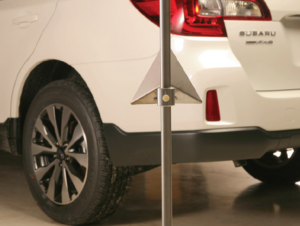
Radar power tests are becoming another post-calibration step
By onAnnouncements | Collision Repair
As the amount of necessary recalibrations grows, so too are the amount of steps that must be completed afterward to ensure a vehicle returns to its pre-collision state, says I-CAR’s director of product management.
Nick Dominato said Tuesday during a Collision Industry Conference (CIC) meeting that radar power tests are now being used to ensure the sensors on damaged bumpers are still working as intended if the bumpers were repainted as part of the repair process.
“As an industry we’re starting to go past calibrations,” Dominato said. “In the last year or two we have really started to see all of these extra things you have to do after a calibration.”
Dominato described radar power tests as processes that ensure the capabilities of radar sensor systems haven’t been reduced by overapplication of material during the repainting process.
“The era of a simple bumper job is over,” Dominato said. “We’re just seeing more and more technology.”

He detailed how blind spot sensors have traditionally been low resolution but have improved recently to help drivers better detect cyclists and small children in blind spots through higher resolution technologies with greater accuracy.
The trouble, Dominato said, is that if too much paint or primer is placed on a pump, it could compromise the sensors’ effectiveness.
“Any physical object you put in front of a radar will reduce its power, however slightly,” Dominato told Repairer Driven News following the conference. “A radar power test is a static function test that uses the radar sensor and a reflector target to determine the extent of the radar power loss due to the bumper and any additional coatings or materials on it.”
Right now, he said he’s only aware of Toyota, Lexus, and Mercedes-Benz requiring the tests on newer models. Toyota and Lexus did not respond to an RDN request for comment.
A Mercedes spokeswoman said post-repair scanning is necessary for all of its vehicles to ensure that safety and driver assist systems are operable and fully functioning.
As additional automakers are expected to adopt 77 GHz radar sensors, Dominato said the power tests will become more common.
“In general, as ADAS capabilities increase and OEMs take on liability, we will see OEMs become increasingly concerned with the proper functioning of the ADAS sensors, including whether they are being obstructed by bad paint or bodywork,” he said. “This will include more function checks, calibrations, and radar power tests.”
Technicians conduct radar power tests by setting a static reflector in front of the radar with the bumper on, Dominato explained. They then initiate a test with a diagnostic scan tool, and radar waves are sent to the reflector and then return back. The vehicle’s software can then determine how much power was lost.
During the conference, Dominato also touched on statistics indicating the auto industry will see a 50% increase in forward-facing cameras by 2026, with 41% of vehicles expected to be equipped with the technology. He said there will be another 50% increase in 2030 when 60% of vehicles will have forward-facing cameras.
Noting that the growth in technology will lead to an increase in calibrations, Dominato said the trend will lead to plenty of opportunities for repairers.
“There’s just so much room to run here,” he said.
He later told RDN: “As ADAS systems get more advanced, we will see more required calibrations, initializations, and function tests, not less. Previously, repairers only needed to worry about whether a repair required a calibration. In today’s vehicles, a repair may require a mounting inspection, calibration, clearing of vehicle history or other system initialization, and radar power test – just for one sensor.
“Soon, it will no longer be just about whether a sensor needs a calibration, but it will be about how many operations does this sensor need due to the repair?”
As the frequency of recalibration grows, other panelists speaking during the meeting said it’s important for shops to ensure their repairers are equipped to complete the job properly.
Mike Muller, aftermarket ADAS engineer at the Detroit, Michigan-based SEMA Garage, said shops should follow the guidance provided by individual OEMs.
“I would also echo that most manufacturers give very specific instructions for what the measurements, lighting, and the wall covering has to be,” Muller said. “Remember when you’re calibrating, you’re calibrating a variety of different sensors that are sensitive to different conditions.”
Images
Featured image: A radar reflector is used for aiming. (Provided by Subaru)
(Left) Nick Dominato, I-CAR’s director of product management, speaks during a Collision Industry Conference meeting. (Right) Fellow panelist Greg Peeters, CEO of Car ADAS Solutions LLC
